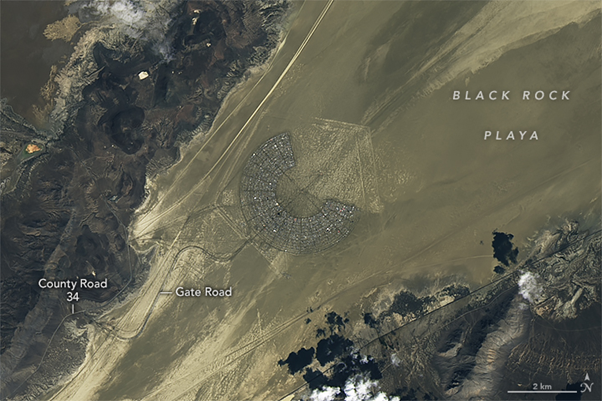When arid environments and human activities interact
The Libyan floods and the 'Burning Man' festival (Sept. 2023)
[Hello to the recent spate of new subscribers - several from a school in a town just north of London. The total number of subscribers is now over 1250. If you want to know more about me and this Substack, then go back to the post of 7th January 2023].
In September 2023, two events took place in arid/desert environments that highlighted the challenges caused by human activities coming up against natural processes. This Substack examines both events.
1. The Libyan floods
Tropical-like cyclones in the Mediterranean, called ‘medicanes’, develop only a few times a year, usually in late summer and autumn. Heavy rain from one such cyclone, Daniel, inundated cities along the northeastern coast of Libya, causing thousands of deaths, one estimate being over 5,000, with 10,000 more being missing. It is impossible to verify these numbers.
The port city of Derna (Darnah), home to about 90,000 people, was one of the worst hit by the storm and suffered extensive flooding and damage. [Figure 1] On September 10/11, over 100mm of rain fell in the area around Derna. The city lies at the end of a long, narrow valley, called a wadi, which is dry except during the rainy season. The floods caused two human-made dams along the wadi to collapse. The failure of the second dam, located just 1km inland of Derna, unleashed floodwater up to 7m high that tore through the city. The flash floods destroyed roads and swept entire neighbourhoods out to sea. Over 3,000 buildings were damaged.
Figure 1. Flooding in Derna, Libya
The rescue effort
Medical teams were flown to Libya to help search for survivors and treat the injured. However, rescue efforts were slow because the flooding cut off roads into Derna.
More workers from Turkey and the United Arab Emirates were sent into Benghazi, a city more than 250km away. The Libyan government based in Tripoli also sent supplies, including body bags and medical equipment, to Benghazi. The Derna City Council called for a safe shipping route to be opened into the port.
US President Biden said America would send emergency funds to relief organizations and that it would coordinate with the U.N. and Libyan authorities. French President Macron also announced financial and other aid for organizations working in Libya.
Other factors
Climate change. Scientists say that climate change may have increased the severity of the storm that caused the flooding. Though climate change is probably making Mediterranean cyclones less common, it is intensifying those that do form.
Vulnerability. Libyans are especially vulnerable with many being ill-prepared to handle the effects of climate change and extreme weather. Most Libyans live in coastal areas at risk of flooding from storms and sea level rise. Towns are built on dry riverbeds, and the parched earth struggles to absorb the heavy rain.
Political instability. Since Muammar el-Qaddafi’s government fell in 2011, Libya has lacked a strong central government. Instead, two rival factions have struggled for control: an internationally recognized government based in Tripoli, in the west, and another group in the east whose domain includes the flooded area. As Daniel approached, the authorities in eastern Libya - who have limited resources - seemed to have no plan to monitor the dams and evacuate residents.
2. The ‘Burning Man’ festival (Nevada, USA)
[Photos – NASA]
Campers at the ‘Burning Man’, an annual arts festival in Nevada’s Black Rock Desert, might have expected to swelter in the late summer sun on a desert playa. However, in early September 2023, attendees encountered a period of unusually heavy rain that turned the flat desert basin into a sea of mud.
This pair of images (Figures 2 and 3) shows the desert on August 26 (first), the day before the festival began, and on September 4 (second), after several months’ worth of rain had fallen in the preceding days. Saturated ground and lakes appear in shades of blue, and vegetation is bright green.
Figure 2. August 26th 2023
Figure 3. September 4th 2023
At a larger scale, and also on Sept 4 below (Figure 4), the dark grey areas shown are areas of saturated mud. Since 1990, festivalgoers have constructed a temporary settlement in the Black Rock Desert during the days of the Burning Man gathering. The 2023 version of the camp is visible in this Landsat image (Figure 4). It is situated in the middle of Black Rock Playa, a flat, featureless expanse stretching northeast for more than 50km. The playa is a remnant of a large prehistoric lake, Lake Lahontan.
Figure 4. Black Rock playa (Landsat)
On September 1, 2023, up to 25mm of rain fell on the playa. (On average, the area receives about 150mm per year, with only 5mm falling in September.) The unseasonable rains were enough to transform the hard-packed desert floor into a muddy slurry.
By the morning of September 3, the surface was still too wet to drive on, and additional drizzle and cloud cover slowed the drying-out process. By midday on September 4, tens of thousands of festivalgoers remained on the playa and were only able to start driving out in the afternoon.







